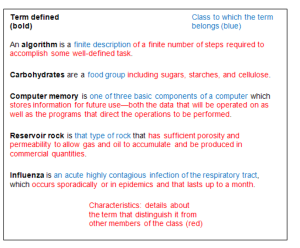10
Communicating with Non-Specialist Audiences
The ability to explain complex, technical matters with ease and simplicity so that a non-specialist audience understands is one of the most important skills you can develop within a technical field. This ability to “translate” difficult-to-read technical discussions is important because so much of technical writing is aimed at non-specialist audiences. These audiences include important people such as supervisors, executives, investors, financial officers, government officials, and, of course, customers.
In writing environments, there are a number of ways to communicate specialized knowledge to non-specialist audiences. A way we will focus on doing this in one of our projects are through formal sentence definitions and extended definitions.
Extended, Formal, and Brief Definitions
When I described the definition method of development, I noted that there were many ways you could give a definition, such as through comparisons or examples. When you give a definition through a comparison or example, you are giving an example of an extended definition. Many types of extended definitions exist, and they help you to explain terms or jargon within your field to a non-expert audience. A list of different types of extended definitions is below. An example of the definition is included for each listed type of extended definition. Be aware that what you see below is not a comprehensive listing of different types of extended definitions you may use.
History
Rutherford Backscattering Spectroscopy was named after Ernest Rutherford, the Nobel Laureate in physics, whose early 20th century experiments in bombarding atoms of various materials with x-rays revealed the structure of the nucleus. As knowledge of the atom advanced, this procedure evolved into an excellent method of measuring the composition of objects without destroying them. Today this method is even used by art historians to analyze paintings and sculpture.
Word Derivation
Diastrophism is derived from the Greek worddiastrophe, whose root meaning is “to turn through.” Thus, diastrophism appropriately names the phenomenon of “turning through,” or deformation, of the earth’s crust that created oceans and mountains.
Contrast
Land treatment should not be confused with landfilling. In land treatment, refinery wastes are spread in a thin layer onto a designated plot of land. These wastes are then cultivated into the soil, where they are broken down and immobilized by soil organisms. Landfilling, on the other hand, is the storage of wastes in a constructed or natural excavation.
Basic Principle
Distillation processes make use of the principle that different liquids will vaporize at different temperatures. That principle allows one liquid to be separated from another by applying heat at the boiling temperature of the desired liquid.
Process Stages
Aeration-by-Turning consists of two stages: 1) tearing down the existing windrow, separating the internal and external layers; 2) rebuilding the windrow so that the internal layer becomes the external layer.
Comparison
A generic peristaltic pump is similar to other pumps you have used, but it contains additional controls to permit use of slow-pumping.
Simile
The action of a semi-rigid joint is similar to what occurs when you pull on a door with rusty hinges. Because of the friction created by the rust, some of the movement of the swinging door is transferred through the hinges to the wall.
Composition
Natural black chalk is a composite of carbon and clay, and is also known as carbonaceous shale. The carbon provides the color; the clay acts as the binder.
Negation
Raw data is not “information”; data only becomes information after it has been evaluated, interpreted, and applied.
Formal sentence definition
A way to explain a term to a non-expert audience is through a formal sentence definition, which includes the term that is being defined, the class or group that term belongs to, and distinguishing characteristics of that term. Formal Sentence Definitions below gives a number of examples for formal sentence definitions.

Formal Sentence Definitions
Source: David McMurrey, Extended Definitions, “Writing Formal Sentence Definitions,” n.d. https://www.prismnet.com/~hcexres/textbook/def.html CC-BY 4.0
Brief Definitions
Use brief definitions when you want to include a quick definition of a single word or phrase in order to better help communicate your message to your audience. You may use dashes, commas, or parentheses to create brief definitions.
Dashes
- It was an effervescent–or bubbling–mixture.
- He was suffering from hypertension–a chronic medical condition
Commas
- It was an effervescent, or bubbling, mixture.
- He was suffering from hypertension, or high blood pressure.
Parentheses
- It was an effervescent (bubbling) mixture.
- He was suffering from hypertension (a chronic medical condition)
Dashes create the most emphasis on the brief definition, while parentheses create the least emphasis on the brief definition. In fact, many readers will skip text if you place it between parentheses. Commas offer a happy medium in terms of emphasis. You will want to consider your audience and writing situation in choosing what method to use.
The process of supplying short definitions quickly is important for communicating with non-specialist audiences. In professional and technical writing environments, you may spend most of your time communicating with those who are not specialists in your field. Brief definitions, formal sentence definitions, and extended definitions all serve as ways you can communicate specialized information to non-expert audiences.
